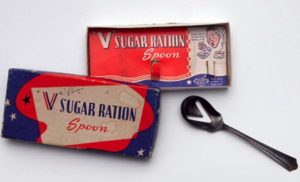 Today, easily available and cheap, sugar, along with corn syrup, is the number one food additive in the United States. Made from sugar cane or sugar beets, it takes a number of forms: white or refined sugar; brown sugar, which is incompletely refined and retains some molasses that gives it color; confectioners’ sugar; and molasses itself, produced during refining. For white sugar, the refining process involves half a dozen steps, starting with the crushing of the cane. The resulting liquid is filtered to remove impurities and the color of the molasses that coated the sucrose crystals of the raw sugar; then the liquid is evaporated and dries into granulated white sugar. If you are avoiding “processed foods”, you must avoid any type of sugar. It doesn’t exist without processing.
Today, easily available and cheap, sugar, along with corn syrup, is the number one food additive in the United States. Made from sugar cane or sugar beets, it takes a number of forms: white or refined sugar; brown sugar, which is incompletely refined and retains some molasses that gives it color; confectioners’ sugar; and molasses itself, produced during refining. For white sugar, the refining process involves half a dozen steps, starting with the crushing of the cane. The resulting liquid is filtered to remove impurities and the color of the molasses that coated the sucrose crystals of the raw sugar; then the liquid is evaporated and dries into granulated white sugar. If you are avoiding “processed foods”, you must avoid any type of sugar. It doesn’t exist without processing.
Now and Then
Sugar provides quick energy, but its nutritional value is essentially nil. Yet, modern-day Americans consume, on average, about 150 pounds of it a year per person in food or drinks, the equivalent of about 32 teaspoons per day. 100 years ago, Americans consumed 4 pounds per person annually.
A visual: Consider today’s Sam’s Club option of a 25-pound bag of sugar, “convenient size”, and “great for baking and everyday use”. In 2017 consumption terms, we will buy six of these bags and store them in our big pantry. In 1917, my great-grandmother would stretch one of these Sam’s Club bags of sugar over five years!
Ohhh Yeeeaaahhh
The WWII ration rules allow my household one cup of sugar per person (including children), per week. At first it doesn’t sound too bad. The 25-pound of Sam’s Club sugar should get me and my hubby through six months of sugar rationing. But, to put it in terms of Kool-Aid making, one cup of sugar in the Kool-Aid mix would mean I am out for that week after one pitcher! Sigh.
For my household, two cups of sugar per week means I don’t bake like I used to. If there’s sugar in the cupboard at the end of the month, I make a pie or a cake. But then we’re wiped out until the new month rolls around.
So What’s a Girl to do?
Under the tight constraints of the rations and workload, more and more home makers were turning to store-bought pastries and desserts. After all, commercial bakeries were not mandated to the same constraints of sugar rationing. At a time when “comfort food” and mom’s apple pie would arguably steady nerves and war emotions, commercialism was stepping in. Many established home makers of the time were well-aware of the intrusion from outside-the-home providers for their family. They didn’t like it. I can’t say I blame them. It was a literal bittersweet goodbye to a long-honored tradition of showing love through homemade food.


